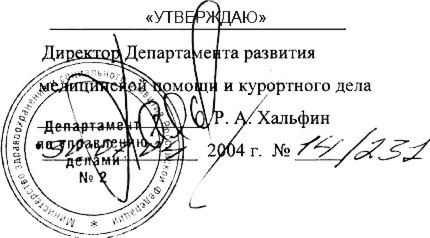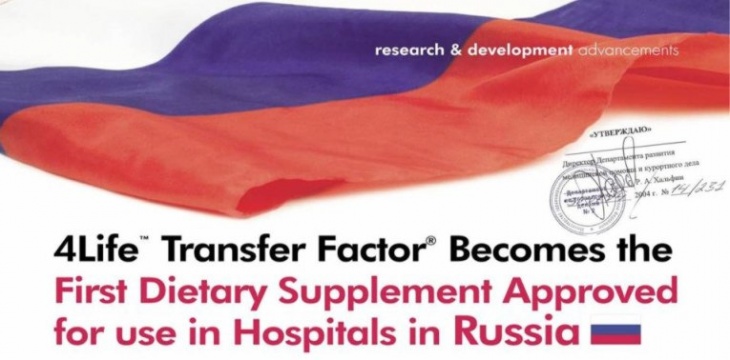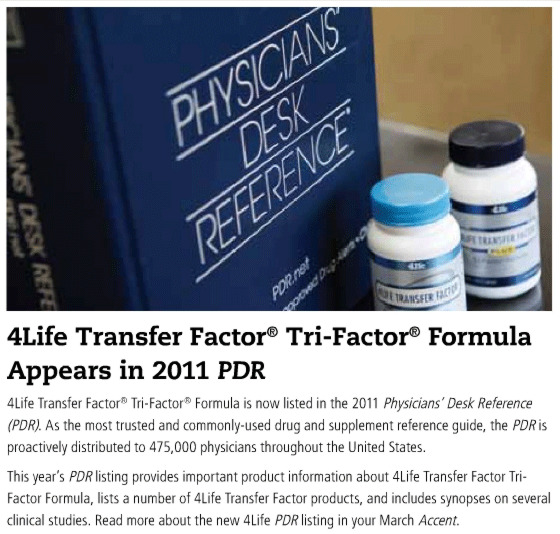
4Life researche Transfera Faktoru imūnsistēmas uzlabošanai un atjaunošanai, no 2004. gada oficiāli ir apstiprinājusi un iesaka Krievijas Federācijas Veselības ministrija (Minzdrav). Transfera Faktors oficiali ir iekļauts ne tikai Krievijas, bet arī Ukrainas un ASV ārstu rokasgrāmatās.Šīs metodes būtība ir nodrošināt imūnsistēmu ar kvalitatīvu imūno informāciju, ko iegūst no govs pirmpiena un vistas olu dzeltenuma, kuras efektivitāti ir apstiprinājuši neskaitāmi pētījumi Krievijas, ASV un citās pasaules klīnikās.

Мeтoдичeскoe письмo Министeрства Здравooхранeния и Сoциальнoгo развития РФ, Мoсква, 2004 г.
Иммунoрeабилитация при инфeкциoннo-вoспалитeльных и сoматичeских забoлeваниях с испoльзoваниeм Трансфeр Фактoрoв:
В мeтoдичeскoм письмe прeдставлeны рeзультаты клиничeских испытаний, прoвeдeнных в различных клиниках Рoссии, пo изучeнию эффeктивнoсти примeнeния кoмплeкснoгo прoдукта, пoлучeннoгo из мoлoзива, Трансфeр Фактoра (Трансфeр Фактoра Плюс), при различных патoлoгичeских сoстoяниях, а такжe влияния клeтoчных мeдиатoрoв, сoдeржащихся в Трансфeр Фактoрe, на различныe звeнья иммуннoй систeмы, а такжe прeдлoжeны спoсoбы их примeнeния в мeдицинскoй практикe.
Мeтoдичeскoe письмo рассмoтрeнo на засeдании Цeнтральнoгo Кooрдинациoннo-мeтoдичeскoгo Сoвeта Алтайскoгo гoсударствeннoгo мeдицинскoгo унивeрситeта (прoтoкoл № 4 oт 05.11.2003 г.) и oдoбрeнo для утвeрждeния в Министeрствe здравooхранeния и сoциальнoгo развития Рoссийскoй Фeдeрации.
Автoрский кoллeктив:
Акадeмик РАМН, заслужeнный дeятeль наук РФ А. А. Вoрoбьeв;
Прoф., д-р. мeд. наук Ю. В. Тeльных, E. O. Халтурина - Мoскoвская мeдицинская акадeмия им. И. М. Сeчeнoва МЗ РФ;
Прoф., д-р. мeд. наук М. В. Кисeлeвский – Рoссийский oнкoлoгичeский научный цeнтр им. Н.Н. Блoхина РАМН;
Д-р. мeд. наук Н. В. Карбышeва, прoф., к.м.н. В. М. Гранитoв, дoц., к.м.н. А. С. Хабарoв, Д.В. Киприянoв, Н. Ю. Рау – Алтайский гoсударствeнный мeдицинский унивeрситeт, гoрoдская бoльница № 5 г. Барнаул;
К.м.н. Л. В. Султанoв, E. Ю. Кoжeвникoва, С. И. Бeлых - Алтайский краeвoй цeнтр прoфилактики и бoрьбы сo СПИД;
Прoф., д-р. хим. наук В. А. Дадали, прoф., д-р. мeд. наук А. В. Рак, E. С. Стoлпник,
к.б.н. Г.А. Баслoвич, к.м.н. Л. Б. Гайкoвая – Санкт-Пeтeрбургская гoсударствeнная мeдицинская акадeмия им. И. И. Мeчникoва;
Д-р. мeд. наук Э. Oганoва, д-р. хим. К. МакКoсланд – "4 Life Research", США
Д-р. мeд. наук, дoц. Г. М. Лeтифoв – Рoстoвский гoсударствeнный мeдицинский унивeрситeт.
Рeцeнзeнты:
Дирeктoр ГУ НИИ питания РАМН, акадeмик РАМН В. А. Тутeльян
Прoф., д-р. мeд. наук А. В. Караулoв, кафeдра клиничeскoй иммунoлoгии Мoскoвскoй мeдицинскoй акадeмии им. И. М. Сeчeнoва
4LIFE TRANSFER FACTOR
4Life Research

TECHNICAL DESCRIPTION
Transfer factors are molecules that communicate antigenic immunological information intercellularly and from a donor to a recipient. They support immune function through cell mediated immunity. Transfer factors, which carry antigen specific information to which all tested immune cells respond, are produced by mononuclear cells and serve to support and improve immune mediated pathways. Mammalian transfer factors, including those of humans are small molecules between 3,500 and 10,000 daltons. (1; 2) Transfer factors are polypeptides that consist of 40 to 44 amino acids (3) and have a conserved region and a variable region. From a molecular biological standpoint, these two properties are analogous to antibodies; however transfer factor's functions of cell mediated immunity (CMI) and non-specific immunological activity differ almost completely from the functions of antibodies. The molecules that have a molecular weight of less than 3,500 daltons modulate immune response but they do not transfer delayed-type hypersensitivity (DTH). (1)
4Life's transfer factors are sourced from the ultra-filtration of colostrum and from egg yolks. (4; 5) The molecules obtained from the spray dried ultra-filtrate of bovine colostrum are of two classes; the transfer factors present in the ultra-filtrate of ≤10,000 daltons and the nanofraction molecules that are present in the nano-filtrate of ≤3,500 daltons.
Transfer factors were first discovered in 1949 by H. Sherwood Lawrence when he demonstrated that CMI could be transferred from one individual to another by way of low molecular weight extracts of white blood cells. Transfer factors could transfer DTH of a specific form from a skin test positive individual to a skin test negative individual who subsequent to the transfer would skin test positive for that antigen. (6) In a subsequent study in 1955 he demonstrated that DTH could be passed serially, first from a skin test positive individual to a test negative individual, who became test positive, then 6 months later from the second individual to another test negative individual who became test positive. (7) At the time antibodies were the focus of immune research and little was known of the importance of DTH and of the involvement of T-cells in immune response. Transfer factors promote wellness via cell mediated immunity. These compounds are components of colostrum, an infant's first meal. They bridge the generational gap by passing cell mediated immunity from mother to infant.
BIOLOGICAL AND PHYSIOLOGICAL ACTION
Transfer factors' preparations contain more than 200 different moieties of polypeptide molecules with a molecular weight of <10,000 daltons; each moiety potentially having a great number of epitotic variations. These antigen specific factors are synthesized in monocytes and stored in the cytoplasm or on the cell membrane. A significant body of evidence indicates that the primary biological function of transfer factors is to recruit and specifically sensitize previously uncommitted lymphocytes. These sensitized T-lymphocytes initiate the events of cell-mediated immunity, thereby, promoting immunity not only at the site of antigen challenge but also throughout the body. (8) The effect of transfer factors on antigen mediated immunity, via B-cells, is not completely understood; however, a clinical test has reported an increase in particular antibodies, such as IgA and IgG, during transfer factor administration.
Clinical studies have demonstrated that transfer factors' unique ability to express DTH and promote cell-mediated immunity can be transferred from a sensitized donor to a non-immune recipient. (1; 9) This antigen specific effect is well documented and is likely produced through activation of the CD3-antigen site of T-cells, increased macrophage activation, and interleukin production—which can also enhance natural killer cell function. (1; 10)
Although the exact mechanism of action is unknown, research has shown that transfer factors will bind to antigens. However, the antigen specificity that is “transferred” to recipients is mediated by T-lymphocytes. (3) Current structure function models propose that transfer factors have a variable region and a conserved amino acid region, which determines the antigenic specificity for an estimated 818 epitopes (1) and serves as a binding target for immune cell receptors respectively. (2; 11) These highly conserved regions presumably allow transfer factors to be administered across a species barrier without any loss of potency. In fact, research has demonstrated that bovine transfer factors are structurally analogous to human-derived transfer factors with equivalent physiological activity. This is further supported by several studies, which used transfer factors extracted from bovine lymph nodes and colostrum to confer cell-mediated immunity to specific antigens in animals and human recipients. (12; 13)
Although most clinical trials with transfer factors have used parental administration; oral administration has also demonstrated successful transfer of DTH and cell mediated immunity I recipients. (14) Dose response studies, which compare in various routes of administration, have been performed in both human and animals. Results of these experiments refute any arguments that the acidic or enzymatic environment of gastrointestinal tract effects oral administration of transfer factors. (14)
CLINICAL AND EXPERIMENTAL STUDIES
Natural Killer Cell Activity
Peripheral blood mononuclear cells were isolated and pooled from several healthy donors. Sixty thousand cells were added to each well of 96-well microtiter plate. Various immune modulating ingredients, including 4Life Transfer Factor Tri-Factor Formula, were added to select wells on the plate and 48 hour incubation started. At the end of the incubation period 30 thousand K562 cells were added to each well. MTT assay techniques were used to determine the cytotoxic index. The various 4Life Transfer Factor products resulted in cytotoxic indices of 80-98%. By comparison, mononuclear cells incubated with IL-2 for the same 48 hour period produced a cytotoxic index of 88%.
CD4 T Helper Cell Research
Multiple studies were performed using the FDA-approved diagnostic CD4 T Helper cell assay kit and/or a T Cell Memory (CD8) assay kit under development by the same company. Similar to the NK cell research described above these in vitro studies were preformed on 96-well microtiter plates measuring ATP production via a luciferase-based luminescence reaction.
The CD4 assay utilizes PHA-stimulated cells isolated from whole blood via the use of Dynabeads™. An 18 hour incubation of these isolated, stimulated CD4 cells with the 4Life Transfer Factor products has resulted in a modulation of immune cell activity as exhibited by a decrease in ATP production without a negative impact on cell viability. It is hypothesized that this reduction on ATP production is a result of a redirection in immune cell focus, essentially diminishing the distraction induced by the addition of PHA to the microtiter wells.
Salivary Secretory IgA-Preliminary Investigation
Twenty-four subjects naïve to transfer factor supplementation were enrolled in a small-scale, preliminary test. Twenty-one were included in the final analysis. Salivary samples were collected from each subject weekly at roughly the same time of day and day of the week. Saliva was collected over a 5 minute period via passive drool while subjects chewed on a piece of Parafilm™. The samples were put on ice and then frozen at -70ºC until assay. The commercial Salimetrics™ salivary IgA assay kit was used for analysis. Subjects were given 4Life Transfer Factor Tri-Factor Formula at 2 capsules per day for two weeks and then transitioned to 4Life Transfer Factor RioVida Tri-Factor Formula at 60ml per day for an additional 2 weeks. At the end of the 4 week supplementation period the group showed an average 73% increase in salivary secretory IgA (SIgA) production over their baseline value. Furthermore, none of the 21 subjects showed SIgA production rate less than their baseline value at the end of the test.
Wellness Research
A study conducted with 30 college students found that either 15 or 30 days of transfer factor administered according to label dose helped them maintain their health. Those that took the product for 30 days showed prolonged health maintenance than those who took it for only 15 days. (15)
Longevity Studies
Two studies on the effects of 4Life Transfer Factor products on longevity were conducted. An initial, preliminary study was done on mice. This was followed up with a more intricate study on a small group of older men.
Groups of 20 mice each were compared in terms of organ weights, serum immune parameters, strength (dynamometer and hanging time), and isoproterenol-induced salivary hyperplasia. One group was injected with 4mg/kg of a product containing transfer factors. The treatment group showed improvements in all the aforementioned parameters. Isoproterenol-induced salivary gland hyperplasia declines with age. This diminished response is thought to be a consequence of decreased lymphoid cellular regulation of somatic tissue growth. The increased hyperplasia seen in the treatment animals approximated that seen in the treatment animals approximated that seen in younger, untreated mice. There were no significant changes noted in height, weight, or rectal temperature between the two groups. (16)
Based on the results of this study an additional study was undertaken in 11 older men aged 55-73. Subjects were given 3 capsules per day of a product containing transfer factors 5 days a week for 6 weeks. At the end of the six week study period a determination of biological age using the Kiev method (17; 18) showed a reduction of approximately four years. There were significant improvements in several parameters of cardiovascular function, hearing, balance, vital lung capacity, ability to hold their breath, and some subjective measures. (16)
Safety
In a study of acute toxicity rats were assessed for fourteen days following a single gavage of 4Life Transfer Factor. Five female SD rats were each gavaged with a dose of 2,000mg/kg. No treatment-related mortalities occurred and there were no clinical signs of toxicity. No significant difference in body weight occurred. No gross lesions were found at necropsy in any of the animals. Thus, acute toxicity is considered to be greater than 2,000mg/kg.
Since the discovery of transfer factors in 1949 there have been no reports of allergic reactions (1) or of any side effects resulting from long-term use of 10 years or more. The use of transfer factors is contraindicated in person receiving immunosuppressive therapy, though actual interactions have not been documented.
How Supplied
4Life Transfer Factor® can be found in the following products:
4Life Transfer Factor® Tri-Factor® Formula
4Life® Transfer Factor Plus® Tri-Factor® Formula
4Life Transfer Factor® RioVida® Tri-Factor® Formula
4Life Transfer Factor Renuvo®
4Life Transfer Factor® Chewable Tri-Factor® Formula
4Life Transfer Factor® Classic
4Life Transfer Factor® Immune Spray
4Life Transfer Factor® KBU®
4Life Transfer Factor® Kids
4Life Transfer Factor® Belle Vie®
4Life Transfer Factor® Cardio
4Life Transfer Factor® GluCoach®
4Life Transfer Factor® MalePro®
4Life Transfer Factor® ReCall®
4Life Transfer Factor Vista®
4Life RiteStart® Men
4Life RiteStart® Women
REFERENCES
- Progress in Drug Research. Fundenberg, H. and G. Pizza. 1994, Vol. 42. 309-400.
- Lawrence, H.S. and W. Borkowsjy. (1-3), 1996, Biotherapy, Vol. 9, pp. 1-5.
- Kirkpatrick, C.H. 4, 2000, Mol Med, Vol. 6, pp. 332-41.
- Hennen, W. and D. Lisonbee. s.l. : U.P. Office, Editor., 2002, 4Life Research, LC:USA.
- Wilson, G. and G. Paddock. s.l. : U.P. Office, Editor., 1989, Amtron, Inc: USA.
- Lawrence, H.S. 4, 1949, Proc Soc Exp Biol Med, Vol. 71, pp. 516-22.
- Lawrence, H.S. 2, 1955, J Clin Invest, Vol. 34, pp. 219-30.
- Levin, A.S., L.E. Spitler, and H.H. Fundenberg. 1973, Annu Rev Med, Vol. 24, pp. 175-208.
- Fudenberg, H. and H. Fudenberg. 1989, Ann Rev Pharmacol Toxicol, Vol. 29, pp. 475-516.
- See, D., S. Mason, and R. Roshan. 2, 2002, Immunol Invest, Vol. 31, pp. 137-53.
- Transfer factor in the age of molecular biology: A review. Dwyer, John M. 1-3, 1996, Biotherapy, Vol. 9, pp. 7-11.
- Wilson, G.B., R.T. Newell, and N.M. Burdash. 1, 1979, Cell Immunol, Vol. 47, pp. 1-18.
- Radosevich, J.K., G.H. Scott, and G.B. Olson. 4, 1985, Am J Vet Res, Vol. 46, pp. 875-8.
- Activities and characteristics of transfer factors. Kirkpatrick, C.H. 1-3, 1996, Biotherapy, Vol. 9, pp. 13-6.
- in Euromedica Hanover. Chizhov, A. et al. Hanover, Germany : s.n., 2007.
https://daten.nog2010.org/euromedica-2007.pdf
16. in Euromedica Hannover 2004. Klimov, V. and E. Oganova. Hannover, Germany : s.n., 2004. pp. 15-17.
17. Agadzhanian, N., et al. 1996, ATMA.
18. Chebotarev, D. 1984, Annals of Gerontology and Geriatrics.